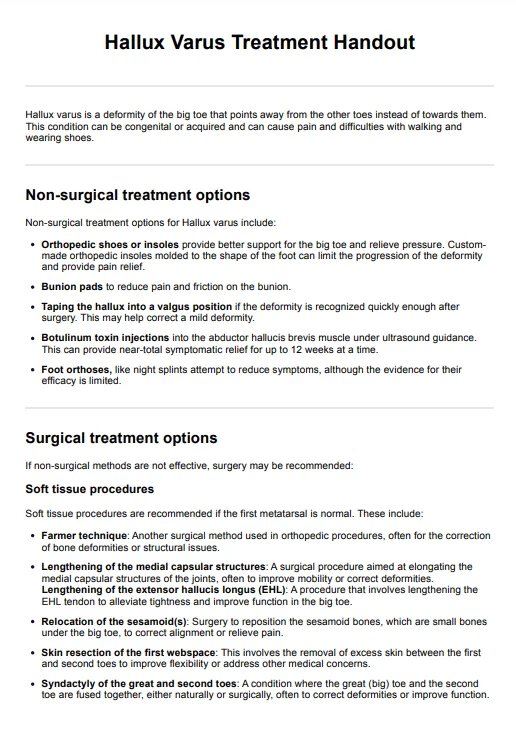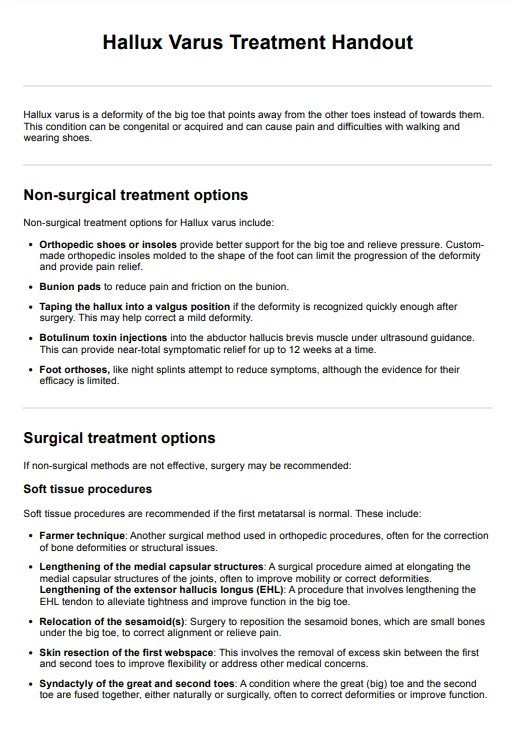Hallux Varus Treatment Guidelines Handout
Explore effective treatments for Hallux varus, including nonoperative and surgical options, and how our template aids healthcare professionals.


What is Hallux varus?
Hallux varus is a foot and ankle deformity in which the big toe is angled inward towards the second toe, away from its normal position due to medial deviation. This condition contrasts with the more commonly known hallux valgus, in which the big toe points outward, forming a medial eminence.
Causes of hallux varus
The most common cause of hallux varus deformity is overcorrected surgery for hallux valgus, commonly referred to as bunion surgery. Other causes include congenital deformities, trauma, and inflammatory diseases such as rheumatoid arthritis that can affect the joints and ligaments of the foot.
Symptoms
Symptoms of hallux varus include:
- A visibly deviated big toe inward toward the other toes.
- Pain and discomfort, especially when wearing shoes or walking.
- Difficulty with balance and an increased risk of falls due to the altered foot and ankle mechanics.
- Formation of calluses or bursitis on the affected toe due to abnormal friction.
Hallux Varus Treatment Guidelines Handout Template
Hallux Varus Treatment Guidelines Handout Example
Hallux Varus treatment
Hallux varus is a condition that requires careful management to restore proper alignment and function of the big toe. Surgical techniques may involve procedures on the proximal phalanx to correct the deformity. Treatment options vary based on the severity of the deformity and the symptoms presented by the patient. Here are the main treatment approaches:
Nonoperative treatment
For mild cases of hallux varus, conservative methods such as physical therapy, orthotic devices, and proper footwear can be effective. These interventions aim to relieve pain and prevent further deviation of the toe.
Hallux varus surgical treatment
Surgery, such as a metatarsal osteotomy, may be necessary to correct the toe’s alignment in moderate to severe cases of hallux varus deformity. Various surgical techniques can be employed for hallux varus, including tendon transfers, osteotomies such as metatarsal osteotomy and proximal phalangeal osteotomy, and joint fusion of the MTP joint. The choice of procedure depends on the patient’s specific condition and overall foot structure.
Postoperative care
Postoperative care, particularly attention to the medial sesamoid and IP joint contracture, is crucial for a successful recovery after surgery. This includes physical therapy, wearing specialized footwear or orthotics, and careful monitoring by a healthcare professional to ensure proper healing and prevent the recurrence of the deformity.
How can healthcare professionals benefit from our template?
Healthcare professionals can greatly benefit from our template as it offers a structured approach to treatment, ensuring consistency and comprehensiveness in patient care. By using the Hallux Varus Treatment Guidelines template, professionals can save time on documentation and focus more on direct patient interactions. The template highlights key treatment strategies, including both non-surgical and surgical options, tailored to various severities of the condition.
Furthermore, including customizable sections allows for adaptation to specific practice needs or patient scenarios, enhancing the relevance and application of the guidelines in clinical settings. This improves patient outcomes by ensuring they receive well-informed, evidence-based care and boosts the efficiency of the healthcare process. Additionally, by standardizing care procedures, the template aids in training new staff and provides a reliable reference for seasoned practitioners, promoting uniformity in treatment approaches across the board.
Commonly asked questions
The first steps usually involve noninvasive methods, such as using orthotic devices or modifying footwear. These initial treatments aim to relieve pain and prevent further deformation.
Surgery is not always necessary. It is considered when conservative treatments fail to provide relief or if the deformity severely affects mobility and quality of life. Surgical options may involve procedures on the proximal phalanx, such as proximal phalangeal osteotomy or tendon transfers, to correct the deformity.
Recovery time varies depending on the type of surgery performed. Generally, it can take several weeks to several months. It's important to follow the surgeon’s post-operative care instructions during recovery.







































































































